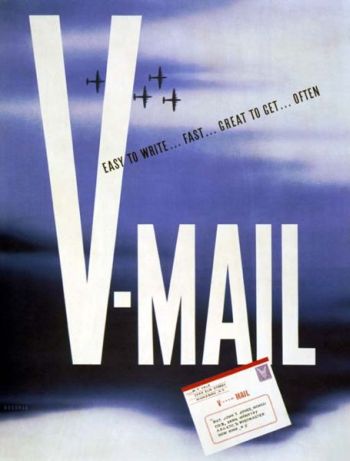V-mail was originally based on the British “Airgraph”, and was an unusual and ingenious system for delivering mail from United States troops to home addresses during World War II. V-mail correspondence worked by photographing large amounts of censored mail reduced to thumb-nail size onto reels of microfilm, which weighed much less than the original would have. The film reels were shipped to the US, sent to prescribed destinations for developing at a receiving station near the recipient, and printed out on lightweight photo paper. These facsimiles of the letter-sheets were reproduced about one-quarter the original size and the miniature mail was delivered to the addressee.
V-mail was composed of a letter that folded into its own envelope. The user would write the message in the prescribed space, fold the letter/envelope form, address it, affix postage and then the mail was on its way.

Propaganda poster produced by the U.S. government during World War II to promote the use of V-Mail.
According to the National Postal Museum, “V-mail ensured that thousands of tons of shipping space could be reserved for war materials. The 37 mail bags required to carry 150,000 one-page letters could be replaced by a single mail sack. The weight of that same amount of mail was reduced dramatically from 2,575 pounds to a mere 45.” This saved considerable weight and bulk in a time in which both were hard to manage in a theatre of the war. It also eliminated the threat of spies using microdots or invisible ink to send reports. Any microdot would not be photographed with enough resolution to be read.
Although the system of V-mail ensured that more pieces of mail were able to be shipped and delivered than a larger, bulkier mailing would have accomplished, many soldiers found that they did not have enough room in the limited available space in order to write all that they had to say.
– Borrowed from Wikipedia, the “free encyclopedia”


2 responses so far ↓
1 Tony Spletstoser // Nov 4, 2008 at 12:08 PM
I’m a WWII Vet who used V-Mail. I was always amazed the way that it worked. I’m still amazed. How were they able to receive all those letters at a West Coast Postal Center, then re-route them to recipients in every direction? At what point were they reduced to microfilm? I was in Entiwetok LST 698. I sent a V-Mail to my Dad who was on a U.S. Hospital Ship that happened to be in the Phillipines. Two weeks later, my Dad’s ship stopped at Entiwetok. He had recieved my V-Mail and contacted my ship and I was able to visit with my Dad. Now, that was fast.
Cheers,
Tony Spletstoser
2 spitballarmy // Nov 16, 2008 at 12:36 PM
Thanks for the comment, Tony.
The U.S. Postal Museum mounted an exhibit all about V-Mail earlier this year. Much of the information from the exhibit has been preserved online at their website: http://www.postalmuseum.si.edu/VictoryMail/index.html.
It is a really good overview regarding the process of and rationale behind this mail delivery system.
Leave a Comment